Nvidia Quadro K5000 Professional Graphics Card Review

The new generation on Nvidia Kepler graphics architecture has finally reached the professional graphics accelerators. We managed to get our hands on the first graphics card with the new architecture designed for high-performance workstations – Quadro K5000. Let’s see how more advanced the new product is compared with the good time-tested Quadro 5000.
Besides catering to gamers with their Radeons and GeForces, AMD and Nvidia also develop graphics cards for professional users. Although both kinds of solutions are actually based on the same hardware components, the two markets are absolutely different for a number of reasons. First and foremost, professional applications for 3D modeling or high-performance computing are quite a different kind of load compared to video games. Then, professional users expect better tech support and have stricter stability and reliability requirements. That’s why graphics cards for CAD/CAM and HPC applications must be discussed separately.
The best illustration of the different nature of the professional graphics market is the fact that it is not shared in the same way as the market of gaming graphics cards. It is dominated by Nvidia which has been enjoying an 80% and higher share for the last several years. And even though the number of professional users is not large compared to the million-strong army of gamers, this market is really important for the GPU makers. Costing about the same money to make as their gaming counterparts, professional products come at much higher prices, bringing in a lot of profit, which is the reason why AMD and Nvidia are both trying to win professional users as well.
Following the release of the new graphics architectures, AMD GCN and Nvidia Kepler, in early 2012, both manufacturers updated their professional product line-ups in the second half of the year. We can note, by the way, that professional solutions come out after their components have been extensively tested in gamer-oriented products. It takes some time to polish off the drivers and additionally verify that the new GPU is compatible with CAD/CAM applications. As a result, Nvidia had only updated its Tesla series by the end of the first half-year, AMD released its new and highly promising FirePro W series in August, and then in September Nvidia came up with its new Kepler-based professional product called Quadro K5000.
Today, we’ll have a look at the latest graphics card from Nvidia designed for high-performance workstations and compare its speed with that of the previous, Fermi-based solution. Unfortunately, we cannot throw an AMD card in just because we did not have one available at the time of the review. In fact, the low popularity of the AMD FirePro series may be partially due to insufficiently aggressive marketing.
Nvidia Quadro K5000 in Detail
The family of Kepler-based graphics cards is structured somewhat differently from others. Normally, a GPU maker focuses on producing a feature-rich top-end solution first and then releases less advanced modifications. It wasn’t so with the Kepler architecture which was first implemented as the GK104 chip, not a top-end GPU at all. The GK110 GPU, the fastest Kepler-based chip, hasn’t yet made it to any graphics card but is limited to Tesla K20 and K20X because of its low-level optimization for computations as well as to certain problems Nvidia and its manufacturing partner TSMC have with mass-producing such sophisticated chips on 28nm tech process.
Thus, today’s Kepler-based graphics cards for gamers and professionals selling under the GeForce and Quadro brands use the well-known GK104 chip. And while there are quite a lot of different GK104-based cards for gaming, there is only one professional product of that kind so far. It is called Quadro K5000.
Positioned as a replacement to the Fermi-based Quadro 5000, the Quadro K5000 comes at a recommended price of $2250 but can actually be found for about $1800. In other words, the two cards are comparable in price. The Quadro K5000 has much better specs, though:
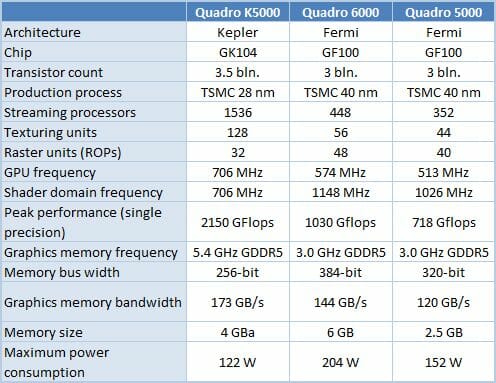
Featuring the same GPU version as the GeForce 680, the Quadro K5000 can offer much higher performance than the previous flagship. Its fully unlocked GK104 chip incorporates 1536 CUDA cores clocked at 706 MHz and complemented with 4 GB of 5.4GHz GDDR5 memory. The clock rates are considerably lower compared to Nvidia’s modern top-end gaming cards, making the Quadro K5000 better in terms of energy efficiency. It is economical not only compared to gaming Kepler-based products but also to professional cards of previous generations.
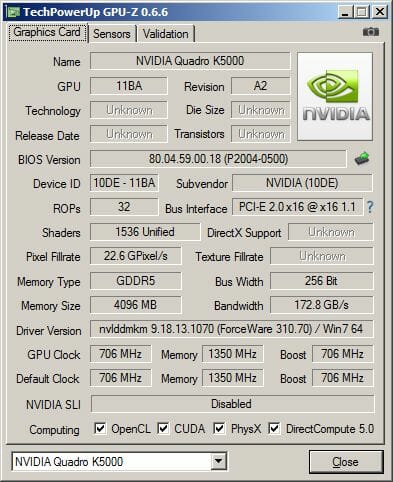
The relatively low level of power consumption is not only due to the reduced clock rates and the lower GPU voltage limit (it’s 0.975 volts now). It is ensured by the entire Kepler architecture which is an improvement on the Fermi in terms of energy efficiency. In its basic structure the GK104 GPU is not unlike its predecessors, though. It contains a GigaThread Engine, memory controllers, an L2 cache for data and instructions, raster operators and, of course, graphics processing clusters that are responsible for computing and texture-mapping operations. The GPU version employed by the Quadro K5000 has four full-featured GPCs each of which includes a raster engine and two streaming multiprocessors (SMXs).
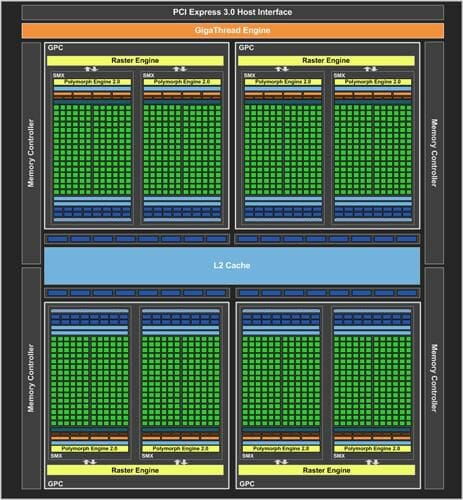
The SMXs are responsible for the bulk of computing done on the GPU. The computing cores are given more emphasis in the Kepler architecture and occupy a larger area of the GPU die than the rest of the logic, including control logic. Thus, the Kepler can be said to have higher computing density than the Fermi, which is good for professional graphics cards that often have to apply same-type instructions to huge arrays of data.
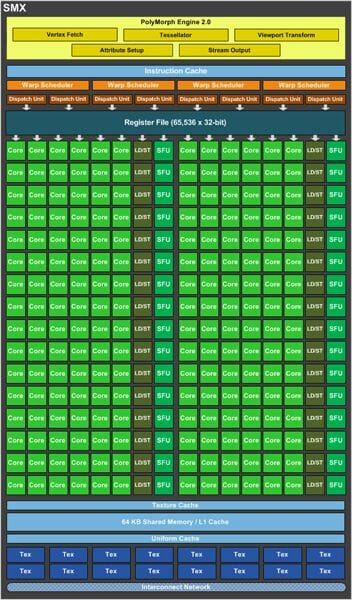
Each SMX contains 192 CUDA cores which is six times the number of SMs in the Fermi architecture. Even though these cores are clocked at the base (rather than double, as before) clock rate, the performance per watt is tripled. Therefore, the Quadro K5000 is not only a fast graphics card. It is also a very energy efficient solution compared to other professional products.
In fact, the low power consumption is indicated by the very exterior of the Quadro K5000. While its face side is covered by its cooler, the reverse side reveals a short PCB we know by gaming cards of the GeForce GTX 670 series.
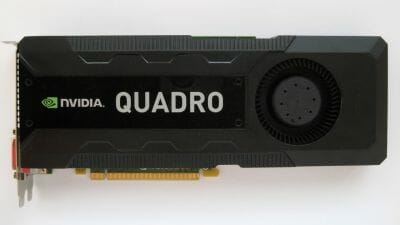
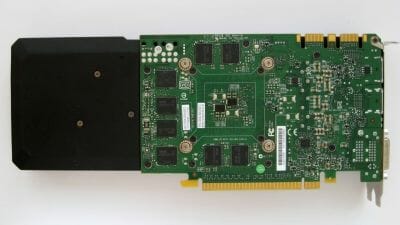
The difference is that the Quadro K5000 is equipped with 4 gigabytes of memory and thus makes use of all available places for GDDR5 chips. The similarity with the GeForce GTX 670 means that the professional card uses a simplified 4-phase GPU power system. It doesn’t seem to need more, though, as it only has one 6-pin power connector.
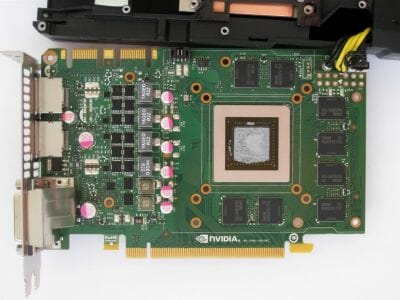
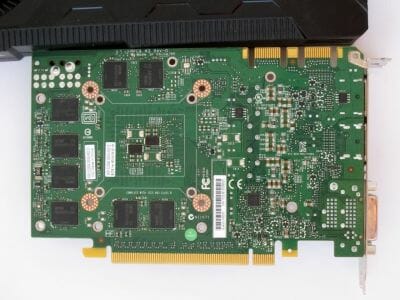
In other words, the reduced clock rates and voltage of the full-featured GK104 chip make the Quadro K5000 even more economical than the GeForce GTX 670. It is an advantage indeed since the professional card not only has a lower temperature but also makes less noise, even at high loads. The peak speed of the default fan was not higher than 1700 RPM whereas the GPU was never hotter than 80°C during our tests. The cooler’s heatsink is larger than the one installed on the GeForce GTX 680, contributing to efficient cooling, too. Take note that the Quadro K5000 with reference cooler is a dual-slot card with a length of 270 millimeters.
Like its gaming Kepler-based counterparts, the Quadro K5000 is equipped with four video outputs: two DisplayPorts, one dual-link DVI-I and one dual-link DVI-D. You can connect up to four monitors concurrently to it, i.e. twice the number of monitors supported simultaneously by Nvidia’s previous-generation professional cards.
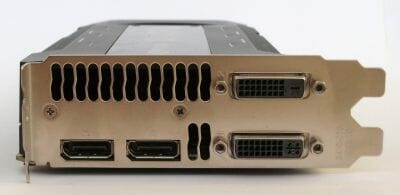
You can additionally increase that number by means of a Quadro Sync card which helps you combine the video outputs of several Quadro K5000 cards installed in the same workstation. For example, a system with four such cards can output a single image to a “wall” of 16 synchronized monitors and Nvidia’s Mosaic technology will spare you the trouble of configuring drivers and other software. The display wall will be identified by the OS as a single display with super-high resolution.
Quadro K5000 cards can also be used in tandem with Tesla K10, K20 or K20X computing cards. Nvidia’s Maximus technology will allow you to run 3D modeling and CUDA-rendering tasks in parallel on the same workstation in this case.
Testbed Configuration and Testing Methodology
We are going to test professional graphics cards in a workstation based on the today’s fastest six-core desktop processor – Intel Core i7-3970X Extreme Edition with the nominal frequency of 3.5 GHz. This platform also used an Intel X79 Express based mainboard and 16 GB of high-speed DDR3-1867 SDRAM.
Quadro K5000 on Kepler design will be competing primarily against the previous generation professional graphics card from Nvidia on Fermi design – Quadro 5000. Moreover, in order to illustrate the performance differences between the general-purpose and professional graphics accelerators, we also included one of the flagship gaming products with the same architecture as Quadro K5000.
Therefore, our complete testbed was configured as follows:
- Processor: Intel Core Core i7-3960X Extreme Edition (Sandy Bridge-E, 6 cores + HT, 3.3-3.9 GHz, 6 x 256 KB L2, 15 MB L3).
- Mainboard: ASUS Rampage IV Formula (LGA2011, Intel X79 Express).
- Memory: 4 x 4 GB, DDR3-1866 SDRAM, 9-11-9-27 (Kingston KHX1866C9D3K2/8GX).
- Graphics cards:
- Nvidia GeForce GTX 680 (2 GB/256-??? GDDR5, 1006/6008 MHz);
- Nvidia Quadro 5000 (2.5 GB/320-??? GDDR5, 513/3000 MHz);
- Nvidia Quadro K5000 (4 GB/256-??? GDDR5, 706/5400 MHz).
- Storage sub-system: Intel SSD 520 240 GB (SSDSC2CW240A3K5).
- Power supply unit: Corsair AX1200i (80 Plus Platinum, 1200 W).
- Operating system: Microsoft Windows 7 Ultimate x64.
- Drivers:
- Intel Chipset Driver 9.3.0.1025;
- Intel Management Engine Driver 8.1.2.1318;
- Intel Rapid Storage Technology 11.6.0.1030;
- NVIDIA GeForce Driver Release 310;
- NVIDIA Quadro/Tesla Driver Release 310;
- NVIDIA 3ds Max Performance Driver 13.00.04;
The tests were executed in 1920×1200 resolution with Vsync disabled. For this test session we used popular CAD and 3D modeling applications and special tests from Special Performance Evaluation Corporation (SPEC). The diagrams below show the scores in points, which means that higher score stands for better performance.
Performance
SPECViewperf 11.0
In our tests of professional graphics cards, we first run SPECViewperf, which has become an industry standard for benchmarking graphics workstations. SPECViewperf sends predefined sequences of OpenGL instructions to the graphics card driver, describing rotations of complex models typical of various professional applications. By simulating such rather primitive operations, this benchmark reports the geometrical performance of a graphics card which is determined by hardware features as well as driver optimizations.
The scripts integrated into SPECviewperf version 11 emulate the user’s work in wireframe mode in the following professional applications (the names of corresponding tests are given in brackets): LightWave (lightwave-01), CATIA (catia-03), EnSight (ensight-04), Maya (maya-03), Pro/ENGINEER (proe-05), SolidWorks (sw-03), Siemens Teamcenter Visualization Mockup (tcvis-02) and Siemens NX (snx-01).
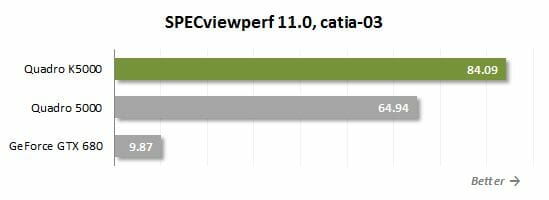
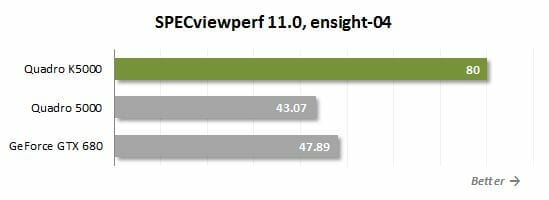
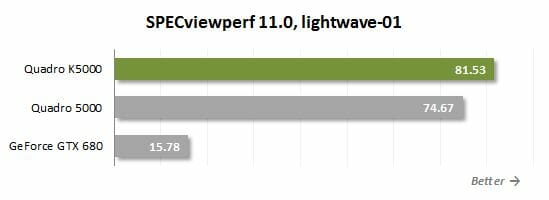
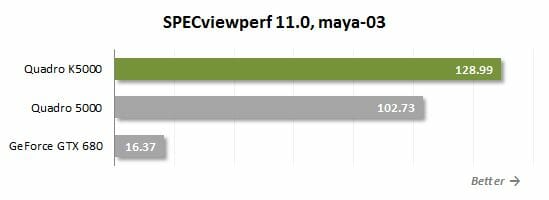
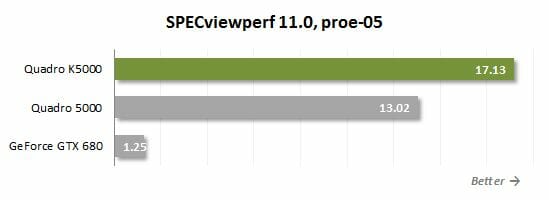
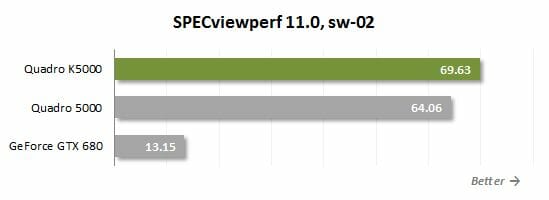
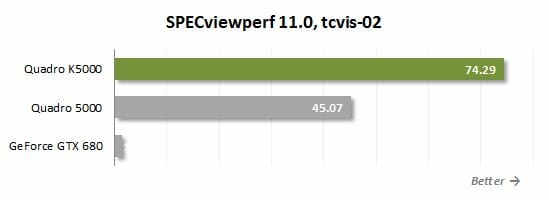
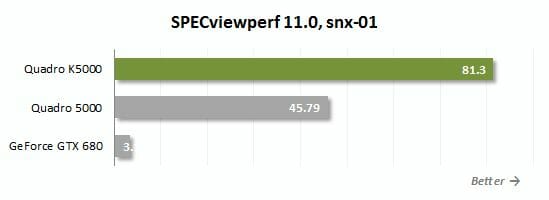
The new Nvidia Quadro K5000 is obviously superior to its predecessor Quadro 5000. The gap varies across the applications, yet the Quadro K5000 is always ahead, proving the worth of the progressive Kepler architecture. It is especially good in the ht-04, tcvis-02 and snx-01 tests where the Quadro K5000 is 70-80% faster than the Quadro 5000. On the other hand, the gap is no larger than 10% in the lightwave-01 and sw-02 scenarios.
Meanwhile, SPECViewperf makes it clear that using gaming graphics cards for professional applications isn’t a good idea. Having the same architecture as the Quadro K5000 and even higher clock rates, the GeForce GTX 680 has huge problems handling complex OpenGL-based models. Its speed is much lower compared to the specialized solutions with optimized drivers.
We can also use SPECViewperf 11.0 to check out the effect of full-screen antialiasing on performance. The diagrams below refer to the standard SPECViewperf tests performed with different FSAA modes turned on.
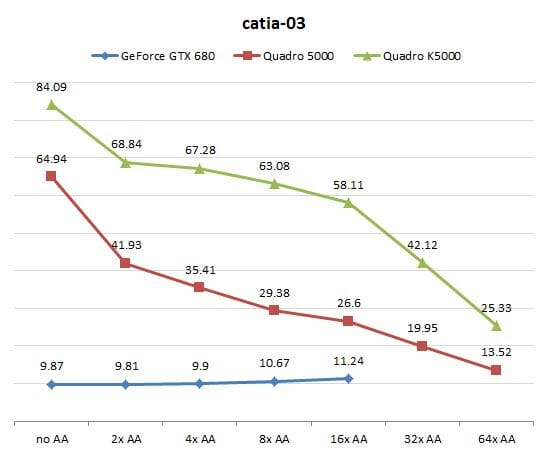
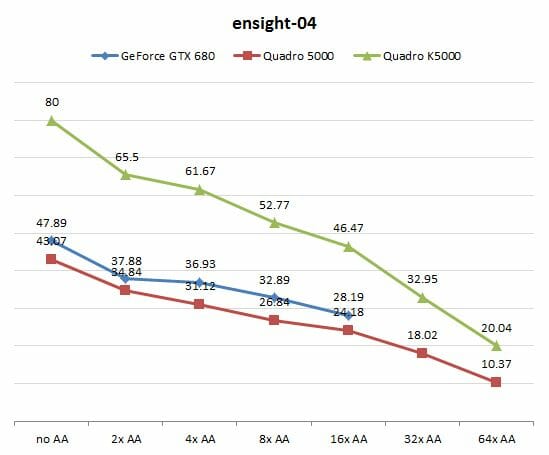
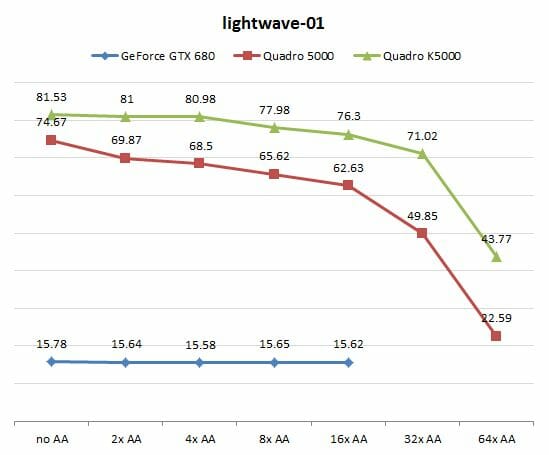
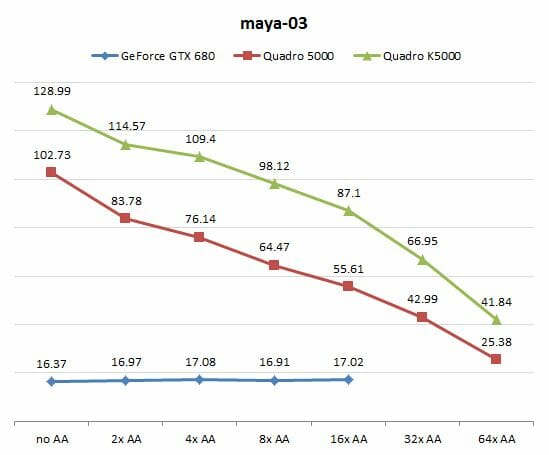
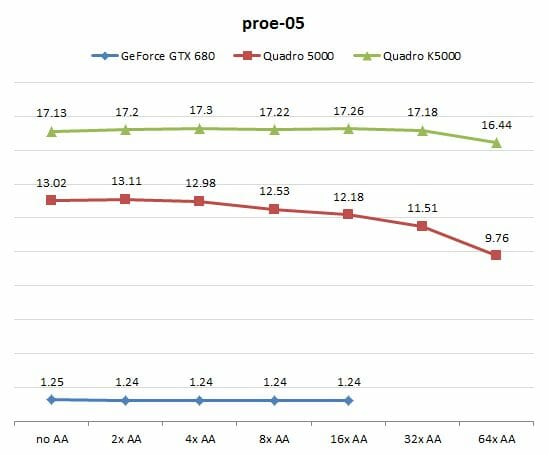
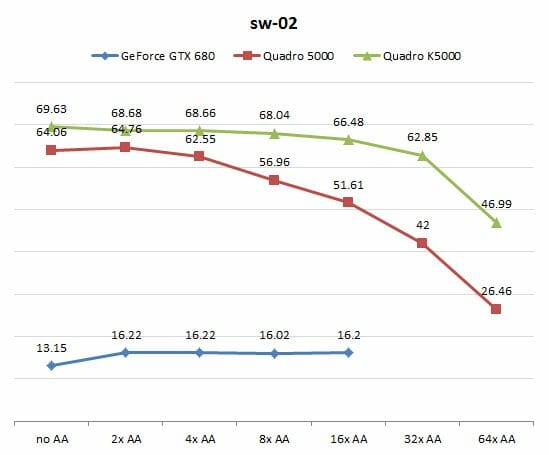
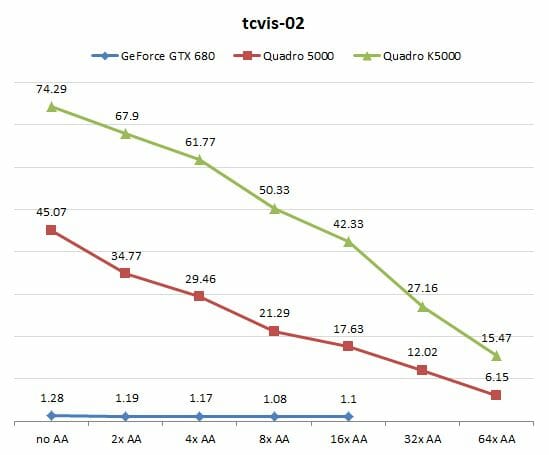
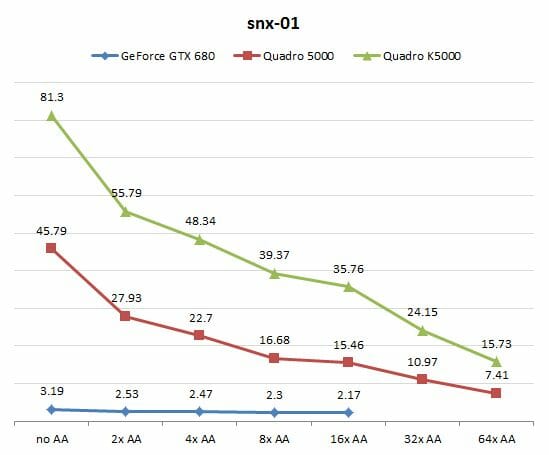
As expected, FSAA provokes a performance hit, but the new Quadro K5000 doesn’t slow down as much as the Quadro 5000. As a result, the newer card is now twice as fast as its predecessor in the 32x and 64x FSAA modes.
While providing a general notion of a graphics card’s performance, SPECViewperf 11.0 is a synthetic benchmark. So we want to complement its numbers with what we have in real-life professional applications.
Autodesk 3ds Max 2011
We used the professional version of the SPEC benchmark to check out the graphics cards’ performance in one of the most popular 3D modeling suites. Besides other things, that version is noted for employing extremely complex models with some 32 million polygons and evaluating performance separately for ordinary and complex models.
It must be noted that Nvidia optimizes its professional solutions for 3ds Max projection windows by offering a special mini-driver that replaces the standard DirectX driver in the software suite and ensures higher performance for the Quadro series.
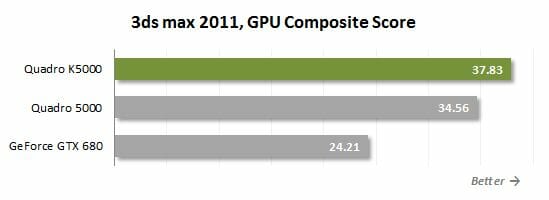
The mini-driver is only compatible with professional Nvidia solutions, which explains the 50% advantage of the Quadro K5000 over the GeForce GTX 680. The benefits of the Kepler architecture show up, too, as the new card is 10% ahead of the Quadro 5000. The high performance of the new Kepler-based professional card is even more pronounced with high-complexity 3D models, though.
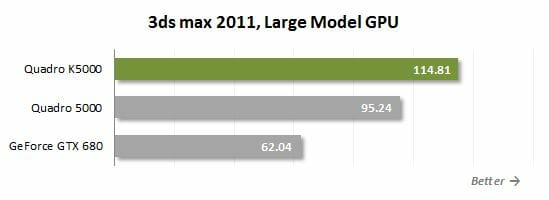
The Quadro K5000 is up to 20% faster than the Quadro 5000 when processing the model of a city built out of 32 million polygons. It is also as much as 85% faster than the gaming card with the same hardware architecture. Of course, we’ve seen even more impressive numbers in SPECViewperf, but we shouldn’t forget that 3ds Max is one of the few 3D modeling suites that work via DirectX.
The overall performance scores do not reflect the whole picture well. We can get a better understanding by analyzing the secondary performance parameters issued by the benchmark.
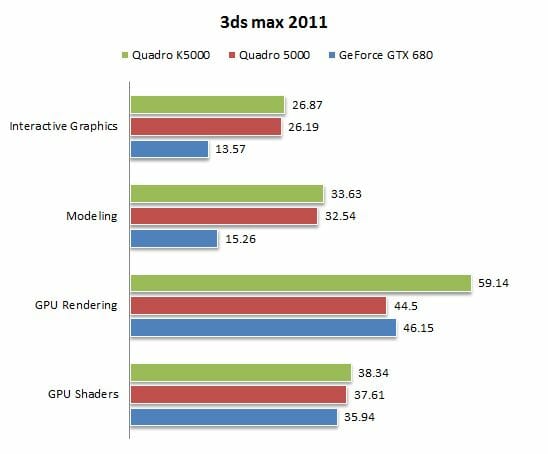
As you can see, the Kepler-based card is largely superior to its Fermi-based predecessor in terms of GPU rendering. That’s just another proof that the GK104 is optimized for high-performance computing.
Autodesk AutoCAD 2013
Here’s another popular 3D modeling suite that uses DirectX. As with 3ds Max, Nvidia offers special support for AutoCAD developers but, unfortunately, the corresponding mini-driver for the Quadro series hasn’t been updated for a long time. Its latest version is only compatible with AutoCAD 2011. That’s why users of this software suite cannot fully benefit from the advantages offered by Nvidia’s latest professional cards. It means that there is no fundamental difference between the Quadro and GeForce series products based on the Kepler architecture.
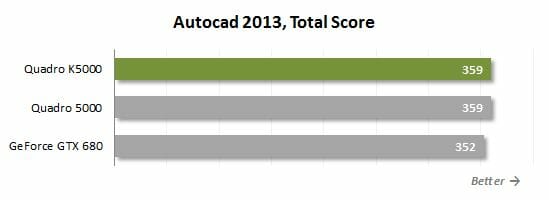
As you can see, the gaming card GeForce GTX 680 is very close in performance to the Quadro K5000. The latter isn’t much different from the previous-generation professional card, either, except for specific situations. They differ when you enable specific visual styles in AutoCAD 2013.
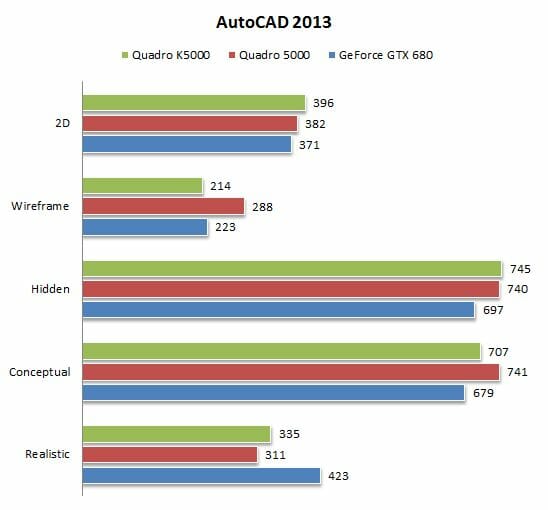
The Quadro K5000 turns out to be better than the other graphics cards at processing 2D design drawings with the Hidden style when objects are represented as carcasses and you can’t see their back edges. The Fermi-based professional card is best in the Wireframe and Conceptual modes whereas the gaming card is most efficient with the Realistic style.
It must be noted that if Nvidia releases its mini-driver for AutoCAD 2013, the situation my change dramatically. Judging by the previous versions, we can expect the Quadro series to get many times as fast as they are now with proper software support.
MAXON Cinema 4D (CINEBENCH R11.5)
Maxon Cinema 4D is a popular software suite for 3D modeling and animation. Its speed can be evaluated by means of the specialized benchmark CINEBENCH. The latter uses the engine of Cinema 4D version R11.4 but, according to its developers, can also provide some notion of a graphics card’s performance in the up-to-date Cinema 4D R14.
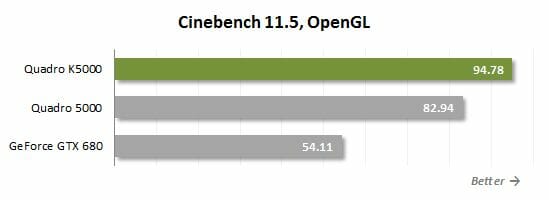
According to CINEBENCH, the new Kepler-based professional card Quadro K5000 is 14% faster than the Fermi-based Quadro 5000.
PTC Creo Parametric 2.0
Creo is a popular CAD suite that has replaced Pro/Engineer. Although based on OpenGL, it runs well enough both on professional and gaming Kepler-based graphics cards.
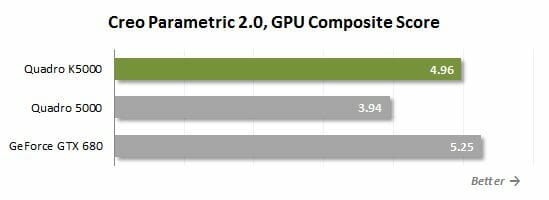
The GeForce GTX 680 is even faster than the Quadro K5000, obviously due to higher GPU and memory clock rates. The new Quadro, in its turn, is better than its Fermi-based predecessor. The difference between them amounts to 25%.
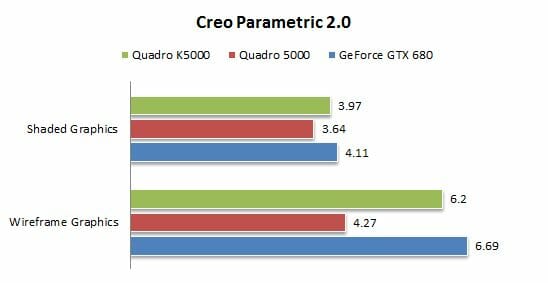
If we take a closer look at the Creo Parametric 2.0 results, we can see that the Kepler architecture enjoys the biggest advantage when processing wireframe models. The Quadro K5000 is up to 45% faster than the Quadro 5000 then.
Autodesk Maya 2013
The popular 3D graphics editor Maya 2013 is a typical professional application based on the OpenGL API. It doesn’t require a special mini-driver. Everything works perfectly well via the generic one.
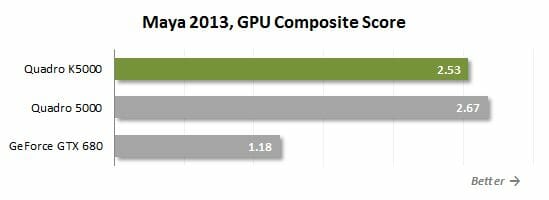
The Quadro series driver has certain optimizations that make such cards twice as fast as the top-end gaming products with the most progressive Kepler architecture. Meanwhile, the Kepler-based Quadro K5000 turns out to be not the best choice for Maya. Its predecessor can deliver somewhat higher performance. Well, the higher overall score of the Quadro 5000 doesn’t mean that this card is better whatever you do in Maya.
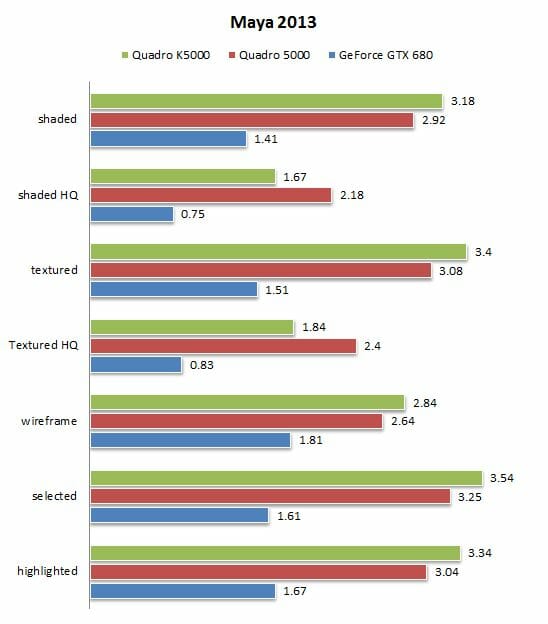
In fact, the Quadro 5000 is only faster than the new Quadro K5000 at processing 3D models with high-quality textures or shading. Otherwise, the Kepler-based card is 8 to 10% faster.
Siemens PLM NX 7.5
NX is the flagship CAD/CAM/CAE PLM-system that is extensively used in engineering, so we just couldn’t help including it into our test session, especially as the new professional card from Nvidia delivers exemplary performance in it.
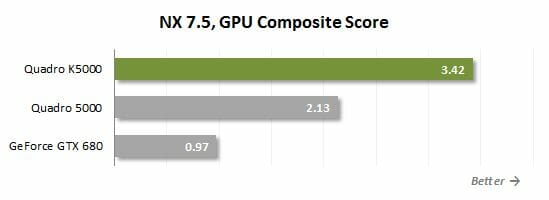
The Quadro K5000 is up to 60% faster than the Quadro 5000 and many times as fast as the gaming card. So, the Quadro K5000 is a perfect choice for a workstation running NX.
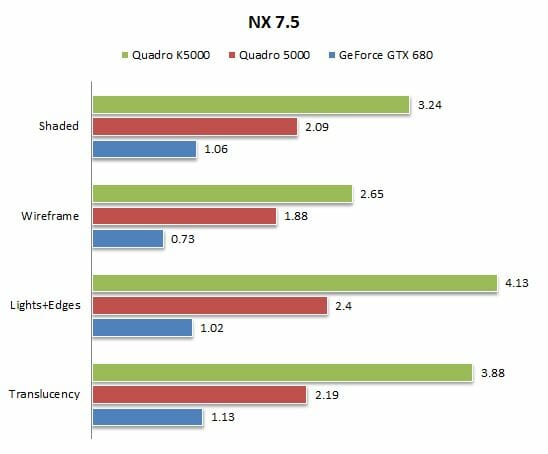
The new card is superior in every scenario but enjoys the biggest advantage at operations with semitransparent models.
Futuremark 3DMark 11
Although professional graphics cards are almost never used for gaming, we still want to run the popular gaming benchmark Futuremark 3DMark 2011 to take a look at our graphics cards from a different angle.
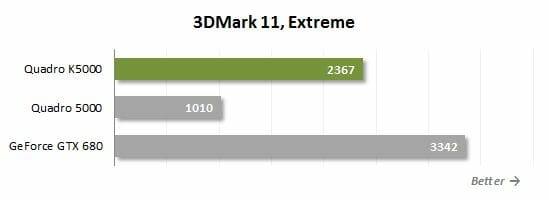
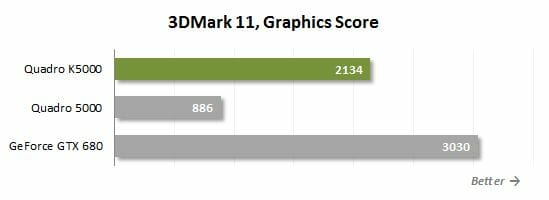
Gaming is different from professional applications, as you can see. The GeForce GTX 680 is much faster than the Quadro K5000, although both are based on the same architecture and even use the same GPU. The GeForce GTX 680 just has much higher clock rates, which cannot but tell on its gaming performance. We didn’t see that in the professional applications. Why? Because of application-specific optimizations which can improve a graphics card’s performance in CAD applications irrespective of its hardware capabilities.
Power Consumption
In this section we want to show you how much power is needed by the complete systems (without the monitor) equipped with the tested graphics cards. We measure the power consumption by means of the Corsair AX1200i power supply. The result is the sum total of the consumption of each system component. The PSU’s efficiency doesn’t affect it.
There are two test modes: idle and high load (FurMark 1.9.2 running in Burn mode in a 1280×720 window). We use FurMark for the high-load mode since, like most professional applications, it is based on OpenGL and is a heavy load indeed.
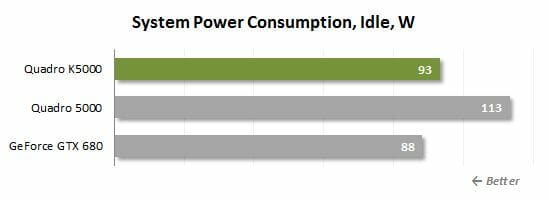
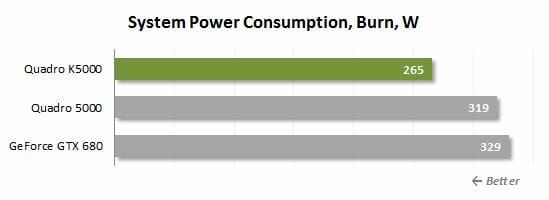
The Kepler architecture is an improvement on the Fermi in terms of energy efficiency, so it is no wonder that the new Quadro K5000 is much better than its predecessor in this test. Although generally faster, it is more economical both when idle and at high loads. In terms of official specs, the Quadro K5000 is about 20% more economical than the Quadro 5000. And as we can see in practice, replacing the old card with the newer one may help you reduce your workstation’s power consumption by an impressive 56 watts.
We can also note that the Quadro K5000 needs much less power than the gaming card with the same architecture. The GK104 seems to be suitable for energy-efficient products if its clock rates and voltage are not set too high. So, it is no problem that the Quadro K5000 has a simpler PCB design than the GeForce GTX 680. The professional card just doesn’t need a more advanced power system.
Conclusion
Having established their reputation as the dominating leader in the professional graphics cards market long time ago, Nvidia doesn’t rest on the laurels but keeps on regularly updating their workstation-oriented offers, introducing new graphics architectures and improving their performance and other parameters. The Quadro K5000 card we’ve tested today is a good example of that tendency. Replacing the Quadro 5000 model, the new product is about 35% faster and some 20% more economical, besides a number of other advantages. Most importantly, the Quadro K5000 is priced typically for its class, which makes it a highly attractive offer for designers and engineers who need high graphics processing performance.
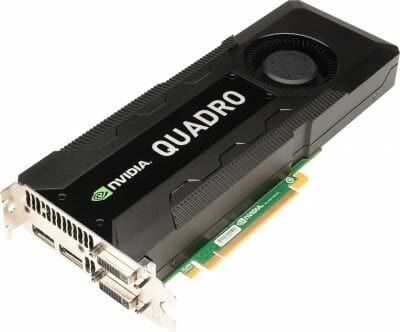
Having done well in gaming cards, the GK104 chip seems to be perfect for professional products as well. Nvidia did not just borrow the successful gaming card design, but also optimized it. First of all, they changed the power profile and clock rates, which explains the high energy efficiency of the Quadro K5000. Second, the professional card comes with more onboard memory, so it can easily cope with complex models and high-quality textures. Third, the Quadro series features CAD/CAM/CAE-optimized drivers. And fourth, the Quadro K5000 supports a new version of the Maximus technology, so it can be used together with Kepler-based Tesla computing cards, and is compatible with the Mosaic technology which allows connecting multiple monitors to it simultaneously.
However, we have some comments for Nvidia programmers. They have mostly to do with the way Quadro K5000 works with AutoCAD 2013. For some reason they haven’t upgraded the AutoCAD mini-driver to support AutoCAD 2013, so the Quadro K5000 cannot show its best in that popular application. The same goes for Creo Parametric 2.0. Hopefully, these downsides will be eliminated very soon. After all, appropriate tech support is what we can expect from professional graphics cards and Nvidia has always been careful about polishing off the drivers to impeccable level.